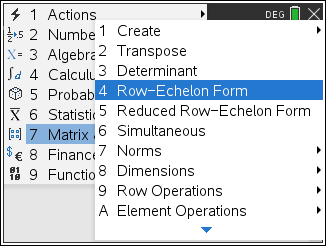Here are some exam-style questions on this statement:
- "(a) Find the equation of the intersection of these two planes:" ... more
- "Consider the three planes:" ... more
Click on a topic below for suggested lesson Starters, resources and activities from Transum.
Furthermore
The angle between a line and a plane is:
$$ \sin^{-1} \frac{|\mathbf{n \cdot d|}}{|\mathbf{n}| |\mathbf{d}|} $$\(\mathbf{d}\) is the direction vector of the line;
\(\mathbf{n}\) is the normal vector to the plane.
The angle between two planes can be found by finding the angles between their normals:
$$ \cos^{-1} \frac{|\mathbf{n_1 \cdot n_2|}}{|\mathbf{n_1}| |\mathbf{n_2}|} $$\(\mathbf{n_1}\) is the normal vector to the first plane;
\(\mathbf{n_2}\) is the normal vector to the second plane.
To find where two planes intersect.
For example:
$$x-3y+2z=8$$ $$3x-9y+2z=4$$Begin by writing the augmented matrix for the system of equations:
$$\left[\begin{array}{ccc|c}1 & -3 & 2 & 8\\3 & -9 & 2 & 4 \end{array} \right]$$We now perform row operations to transform this matrix into echelon form:
\(R2 = R2 - 3 \times R1\)
$$\left[\begin{array}{ccc|c}1 & -3 & 2 & 8\\0 & 0 & -4 & -20 \end{array}\right]$$Two planes in space could be intersecting, parallel or coincident.
from \(R2\) it can be seen that \( z=5 \)
from \(R1\) it can be seen that \(x\) and \(y\) can have infinitely many values so let \( y=t \)
from \(R1\) it can be seen that \( x=3t-2 \)
The planes intersect along the line defined by a vector equation, \( \mathbf{r} \). Let \(t = 0\) to find a point on the line: \( (-2,0,0) \)
$$ \mathbf{r} = \begin{pmatrix} -2 \\ 0 \\ 0 \end{pmatrix} \quad + \quad t \begin{pmatrix} 3 \\ 1 \\ 0 \end{pmatrix} $$To find where three planes intersect solve their equations simultaneously.
For example:
$$x+y+z=3$$ $$2x-y+z=0$$ $$x-2y-z=-3$$We begin by writing the augmented matrix for the system of equations:
$$\left[\begin{array}{ccc|c}1 & 1 & 1 & 3\\2 & -1 & 1 & 0\\1 & -2 & -1 & -3\end{array}\right]$$We now perform row operations to transform this matrix into echelon form:
\(R2 = R2 - 2 \times R1\)
$$\left[\begin{array}{ccc|c}1 & 1 & 1 & 3\\0 & -3 & -1 & -6\\1 & -2 & -1 & -3\end{array}\right]$$\(R3 = R3 - R1\)
$$\left[\begin{array}{ccc|c}1 & 1 & 1 & 3\\0 & -3 & -1 & -6\\0 & -3 & -2 & -6\end{array}\right]$$\(R3 = R3 - R2\)
$$\left[\begin{array}{ccc|c}1 & 1 & 1 & 3\\0 & -3 & -1 & -6\\0 & 0 & -1 & 0\end{array}\right]$$The augmented matrix is now in the form:
$$\left[\begin{array}{ccc|c}a & b & c & d\\0 & e & f & g\\0 & 0 & h & i\end{array}\right]$$If \( h \neq 0\) there is a unique solution.
If \( h = 0 \text{ and } i \neq 0 \) there is no solution
If \( h = 0 \text{ and } i = 0 \) there are infinitely many solutions (let \(z=t\)).
In the example above ...
from \(R3\) it can be seen that \( z=0 \)
from \(R2\) it can be seen that \( y=2 \)
from \(R1\) it can be seen that \( x=1 \)
The planes intersect at \( (1,2,0) \).

Aide Memoire
Intersections of a line with a plane: Substitute parametric expressions into plane equation then solve to find the paramater.
Intersections of two planes: Solve simultaneous equations by introducing a parameter or find vector product of normals if a common point is known.
Intersections of three planes: Solve simultaneous equations using augmented matrix row reduction.
Angle between a line and a plane: 90° - angle between direction of line and normal to the plane.
Angle between two planes: Find angle between the normals of the plane.
How do you teach this topic? Do you have any tips or suggestions for other teachers? It is always useful to receive feedback and helps make these free resources even more useful for Maths teachers anywhere in the world. Click here to enter your comments.

